
Aloxy
ID: 3460
September 13, 2021
End-to-end IoT solutions make assets smart, automate processes and deliver actionable insights into industrial operations.
ID: 3923
February 7, 2022
Awake.AI works to accelerate a transition towards sustainable and intelligent maritime logistics. By offering a collaborative data platform, the company empowers sea, port and land ecosystem partners to embrace digital operations. The platform provides a medium for better collaboration and planning between all actors involved in the maritime logistics chain. It combines raw data from all logistics operations and turns it into insights that facilitate automation and enriched decision-making for any actor at their individual stage of the logistics process.
Awake.AI was founded in October 2018 by an experienced team that was previously part of shaping the marine industry with innovations such as the world’s first vessels with situational awareness, remote control and autonomous functionality. The company is located in Finland with 30 employees from a variety of backgrounds including maritime logistics, software development, AI and analytics, cyber security and platform economics.
Awake.AI works with maritime actors all over the world, helping them to automate and digitalise their logistics operations and providing support all the way from conceptualization to design, implementation and optimization. The company serves the needs of all the various actors involved in the maritime logistics chain by bringing together the operations on sea (vessel operators), port (port authorities, terminal operators) and land (cargo transporters and owners).

The incentive of Awake.AI to develop their IoT solution derives from the global ambition of transitioning logistics processes into more sustainable and intelligent ecosystems. For Awake.AI, the ambition is fuelled by an aim to optimise logistics in the maritime industry for increased operational efficiency, cost savings and reducing emissions.
“Driving the digitalisation in the maritime logistics field is the main goal.”
Jussi Poikonen, Co-founder and Vice President at Awake.AI
Prior to the foundation of Awake.AI, several of the employees were working at the Rolls Royce Marine Ship Intelligence unit, focusing on unmanned vessels and remote-controlled shipping. Here, they experienced that although they were technically able to develop these autonomous vessels, the remaining maritime infrastructure was not able to handle them. At the same time, they were seeing increasing environmental issues in maritime logistics. These realisations led the team to initiate collaborative activities with port authorities, port operators and cargo owners who wanted to be forerunners in maritime digitalisation. Insights from this collaboration made the founders of Awake.AI realize that smart ships cannot interact with the rest of the logistics chain unless the needed digital interfaces and machine learning models are developed and linked to an open sharable platform.
“So an idea about a platform connecting vessels and the shore side started growing, and that is the short version of how Awake was established.”
Anssi Lappalainen, Senior Product Manager at Awake.AI
The idea was realised in 2018 with the foundation of Awake.AI. During the initial life cycle phase, the company joined forces with many subcontractors to cover all relevant aspects such as technical capabilities, cyber security, software development etc. while accelerating development. Today, the company has been operational and rapidly growing for two years, and it is now able to cover all the needed capabilities internally. A landmark was reached in 2021 when the company reived Frost and Sullivan’s “Entrepreneurial Company of the Year Award” for excellence in best practice within European maritime logistics.
Awake.AI plans for their solution to be as scalable as possible, having already reached broad geographical coverage with several international customers. While connecting stakeholders of the maritime ecosystem, enabling more fluent communication and collaboration between all operators of the logistics chain, the company strives towards becoming the world’s most trusted smart port and autonomous shipping platform.
“The purpose of our work is to connect different stakeholders from the sea, port and landside, and enable something we call collaborative operational planning.”
Anssi Lappalainen, Senior Product Manager at Awake.AI
In recent years, actors in global maritime logistics operations have been constantly required to adjust their strategies and establish digital competence to comply with increasingly stringent environmental regulations and performance requirements. However, today’s maritime logistics chain is characterized by the so-called 4×40 problem: vessels sail empty up to 40 % of their sailing time and spend up to 40 % of their time waiting in port. Solving these problems holds the potential to improve operational costs by up to 40 % and reduce global shipping emissions by more than 40 %.
“They are slowly realizing that they need to adopt into something new. But quite often they do not know what it is.”
Anssi Lappalainen, Senior Product Manager at Awake.AI
The identified cause of the 4×40 problem lies in a lack of transparency and poor communication and collaboration among the maritime logistics stakeholders. They are doing their planning and operations in silos and do not share information. A typical example of this is as follows:
When a vessel is arriving at port, the captain is responsible for informing the port about the Estimated Time of Arrival (ETA). This notice is usually given by phone or email up to 24 hours before arrival. Hence, the ETA notice reaches only one person at the port side, and the actual time of arrival may furthermore vary by several hours due to unfortunate weather conditions and other unforeseen circumstances. This causes a severe inefficiency challenge throughout the logistics chain, as none of the actors can plan operations more than 24 hours ahead, and if changes occur, they are rarely communicated. For port operators, it complicates navigation and coordination of traffic in the port, and for land operators such as trucking companies, it complicates planning of arrival times to come and pick up cargo from the vessel.
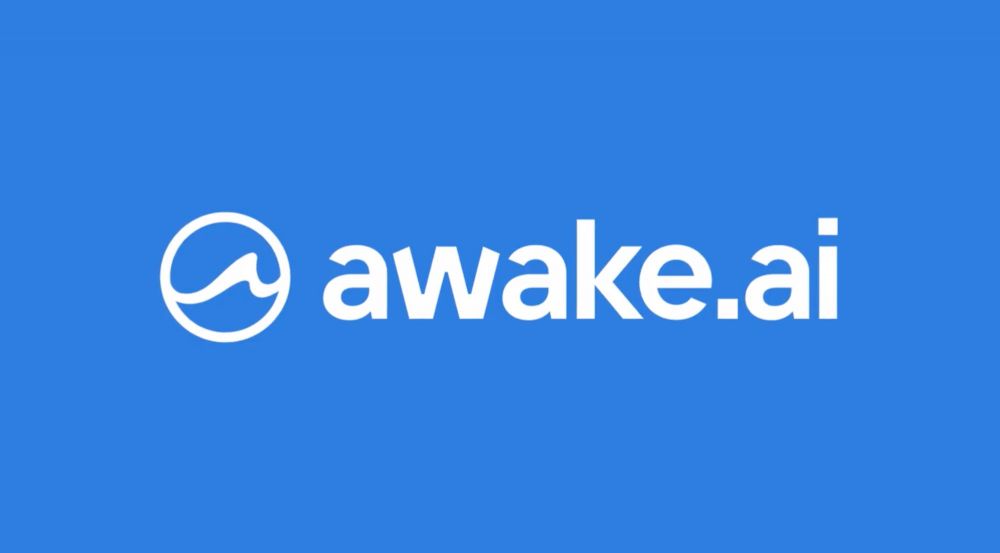
Awake.AI’s approach to the problem is an open platform that allows the user to automatically monitor the timings of other maritime logistics actors without human estimations and actions, providing awareness about when the vessel is de facto arriving in the port.
“The maritime industry is so conventional and changes are rare. …They understand that digitalisation is coming, but they do not understand what it requires.”
Anssi Lappalainen, Senior Product Manager at Awake.AI
Hence, it is essential for Awake.AI to inform the maritime actors about the value of sharing and digitalising upcoming operations, as it benefits both individual and collective business, by enabling each actor to better plan their operations and thereby increase efficiency, save money and, at the same time, reduce CO2 emissions tremendously.
The solution offered by Awake.AI covers a collaborative software platform and its appertaining digital interface application called “Smart Port as a Service”. The solution relies on various data sources such as the AIS [1] and VTS [2] systems of the vessels and numerous IoT and camera sensors – some of them already deployed by the maritime operator for various purposes (e.g. weather data, water levels, air quality, pollutant gasses etc.) and some of them installed by Awake.AI as part of increasing coverage of the solution. The data is transmitted from the various sources via VHF [3] radio and internet connection to receivers, satellites and launch stations, from which it is passed on to Awake.AI’s cloud platform. However, for a range of specific services of the solution, a portion of the data is handled instantly by the devices at edge level.
The Awake.AI platform processes the collected data into information that creates holistic situational awareness throughout all areas of the logistics chain:
The platform connects via API [4] with the information systems of the different actors in the maritime logistics chain, enabling bidirectional flows of information to and from the platform.
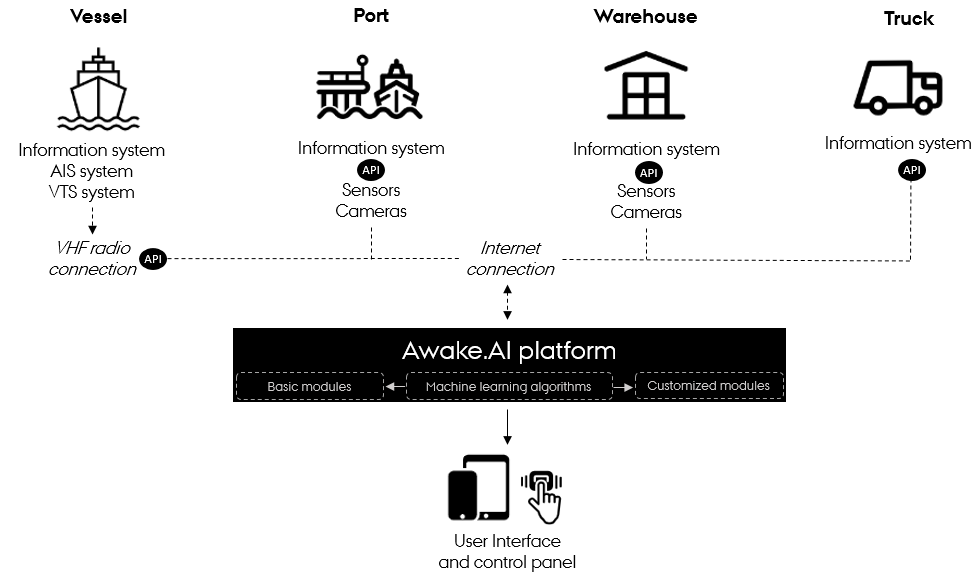
Illustration 2: Enabling technologies for Awake.AI’s “Smart Port as a Service” platform solution.
The “Smart Port as a Service” application includes a range of basic and ready to use modules as listed in illustration 3 below. These modules provide a user-friendly interface for framing the features of the platform that empower smarter and more modern maritime operations:
All information and features of the modules are accessed and controlled by the user via web or mobile. Awake.AI’s solution is agile and supports not only the basic modules, but also customized features that are tailored to the needs of specific users. The company’s custom solution portfolio includes industry-specific solutions such as simulations, digital twins, and monitoring and reporting tools based on computer vision.

The modules and custom features provide situational awareness and real-time insights that are valuable for all the maritime actors, although the information may be used for different purposes:
The offering of Awake.AI is an end-to-end solution that includes introduction to the platform, guidance upon functionalities, configuration of the customer’s port and calculation of potential cost savings prior to deployment.
The development of Awake.AI’s solution is an obvious contribution to the global ambition of fostering more sustainable and intelligent logistics. By digitalising the entire maritime logistics chain, the sea-port-land ecosystem is interconnected, the information between stakeholders becomes fluid and the throughput is maximized without investments in expensive physical infrastructure. The services offered in the solution directly impact the 4×40 problem and address the concerns of non-optimal operational efficiency, lack of transparency and environmental damage.
“These services are enabling modern forward-thinking ports and planning in a more agile way than before.”
Jussi Poikonen, Co-founder and Vice President at Awake.AI
By integrating IoT into the traditionally analogue processes of maritime logistics, Awake.AI equips operators to allocate their resources better, save time and resources, improve their profit performance and ultimately deliver more value to their stakeholders. Providing on top also AI-driven recommendations, the solution modernises the entire industry through operations optimisation, asset efficiency, JIT resource deployment and insights to plan future operations well in advance while making fuel consumption more efficient and reducing costs.
The ambition of Awake.AI’s solution is manifested as outcome through a continuous profit mechanism that is based on income via monthly subscriptions. This revenue model benefits Awake.AI as well as the customers, as the platform is running on cloud-based software and therefore requires no expensive upfront capital investments.
For users of the solution, the direct outcome is the situational awareness and information sharing throughout the logistics chain, which facilitates a better flow in the operations of the individual maritime actors:
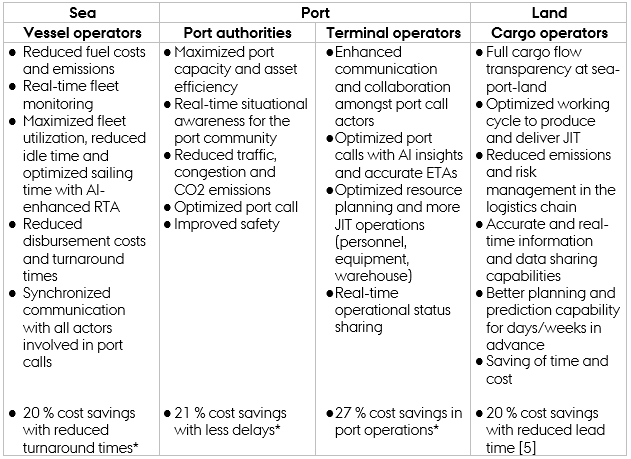
Awake.AI’s platform solution essentially enhances coordination, planning and forecasting, making the entire logistics process more punctual while at the same time more agile. Ultimately, the cargo owners, at the very end of the logistics chain, are the ones to reap the most beneficial outcome of Awake.AI’s solution; a more precisely scheduled and faster delivery of the cargo.

The value for the individual user of Awake.AI’s solution increases progressively with the collective amount of platform users. Although any maritime operator is able to use the solution alone, more beneficial outcomes are gained when other stakeholders in the logistics chain are also using it.
“With platforms, you need the critical mass to use it to get the most out of it. That has been the most challenging part; selling to the whole port community.”
Anssi Lappalainen, Senior Product Manager at Awake.AI
Since Awake.AI introduced their solution and the value to gain from integrating intelligence into maritime logistics, digitalisation readiness of the ecosystem has gradually transpired. Many iterations and adaptations have passed since the first release of the platform, and Awake.AI has gained many learnings along the way. Some of these learnings may have transmissible value for other actors maneuvering in the IoT ecosystem.
Offering an IoT-based solution to a highly conventional industry does, however, imply one key challenge in terms of adoption resistance: In this case from several of the maritime actors to digitalise and share data with others in the logistics chain.
“I’ll show you mine and you show me yours! They do not trust it. So we have to really show to them somehow that there is value in it.”
Anssi Lappalainen, Senior Product Manager at Awake.AI
Therefore, an essential organisational learning for Awake.AI has been to infuse trust-based mechanisms into their solution that establish high levels of trust in the data sources and the trustworthiness of the data. By guaranteeing state-of-the-art security governance and security operation models in the platform, Awake.AI responds to the concerns of users and takes responsibility for cyber security and data sharing aspects.
Awake.AI considers a number of points to be vital for the success of their IoT solution. Taking departure in the development of the software platform and its appertaining “Smart Port as a Service” application, these points are compiled into a list of recommendations below:
1. Orchestrate a partner ecosystem
Awake.AI puts great effort into gathering companies and orchestrating them in a partner ecosystem in order to share information and ideas for developing the best solutions to the industry.
“As a small start-up, we cannot do everything ourselves. But we have customers, producers, subcontractors… Basically, with these partners, we can develop our future solutions.”
Anssi Lappalainen, Senior Product Manager at Awake.AI
Hence, developers are advised by Awake.AI to partner up with other companies and ideate solutions that can be made in collaboration, and basically, not to try doing it alone.
2. Mass collect data
“From the start of our company, we have very carefully collected all the data that we can get our hands on!”
Jussi Poikonen, Co-founder and Vice President at Awake.AI
Awake.AI recommends anyone with an IoT-based business model to do the same. For Awake.AI, this work has resulted in a valuable base of historical data, which is used to develop prediction models that are now sold as services.
3. Inform and educate your customers while learning from them
Ports are usually community-owned, and operators rarely have a clearly defined request, which makes sales cycles and decision-making slow. In this setting, Awake.AI emphasizes the importance of assisting the potential customer by putting an effort into informing the customer about the possibilities of the solution as well as educating about the central services and features for the individual operator.
“The key thing is of course to understand what the customer really and actually needs – and it is not always what they tell you they need!”
Jussi Poikonen, Co-founder and Vice President at Awake.AI
Awake.AI has approached this by actively working with pilot customers, offering buffering services and development to learn about needs and running campaigns where the solution is offered for free – all to kick-start an up-selling process.
4. Focus on the big fish
“If we get the big fish, then the rest will follow.”
Anssi Lappalainen, Senior Product Manager at Awake.AI
Experience has taught Awake.AI the significance of identifying first movers in the target market when building a platform community and customer base. Resources should then be allocated to acquire the dominating actors among these, e.g. by contacting them to learn about their requirements and challenges, presenting one’s solution to them and providing demo access.
One final reflection from Awake.AI encapsulates the general theme for the success of their solution, as well as for succeeding with any business endeavour in the world of today:
“Digitalisation in general is one of the easiest ways to make your business model sustainable.”
Anssi Lappalainen, Senior Product Manager at Awake.AI
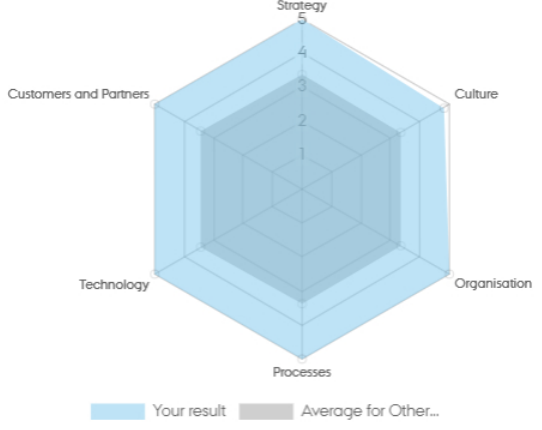
Awake.AI assumes a high level of digital maturity with an overall score of 4.97. The score indicates that the digital capabilities of the company are vastly mature, and that they perform above average for the sector.
The Digital Maturity Assessment Tool is copyrighted by Associate Professor and PhD Annabeth Aagaard, Director at the Interdisciplinary Centre for Digital Business Development, Aarhus University. To get the digital maturity of your company mapped out, click here.
[1] AIS (Automatic Identification System): vessel-system that transmits a ship’s position so that other ships are aware of its position. The International Maritime Organization and other management bodies require large ships to broadcast their position with AIS in order to avoid collisions.
[2] VTS (Vessel traffic services): shore-side systems that range from the provision of simple information messages to ships, such as position of other traffic or meteorological hazard warnings, to extensive management of traffic within a port or waterway.
[3] HF (Very High Frequency): worldwide radio system used for bidirectional voice communication from ship-to-ship and ship-to-shore. VHF includes radio waves from 30 MHz to 300 MHz.
[4] API (Application Programming Interface): interface that enables two pieces of software to communicate. May be used on web-based systems, operating systems, database systems and computer hardware to access data, server software or other applications.
[5] The numbers represent annual saving in revenue assuming 500 ships per year with an average arrival delay of 3 hours per ship.
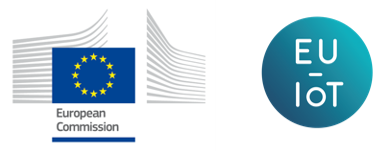
Copyright notice: © 2020 – 2023 EU-IoT Consortium.
This material was produced as part of the EU-IoT project, grant ID 956671, and is funded by the Horizon 2020 Framework Programme under topic ID ICT-56-2020.
EU-IoT is the European IoT Hub. The EU-IoT project works towards growing a sustainable and comprehensive ecosystem for Next Generation Internet of Things.
Source of origin: Information to document this use case originates from the H2020 call: ICT-56-2020 Next Generation Internet of Things (RIA); Project INGENIOUS 957216; Period: 01-11-2020 to 31-03-2023; EC contribution 8 mil. EUR.
